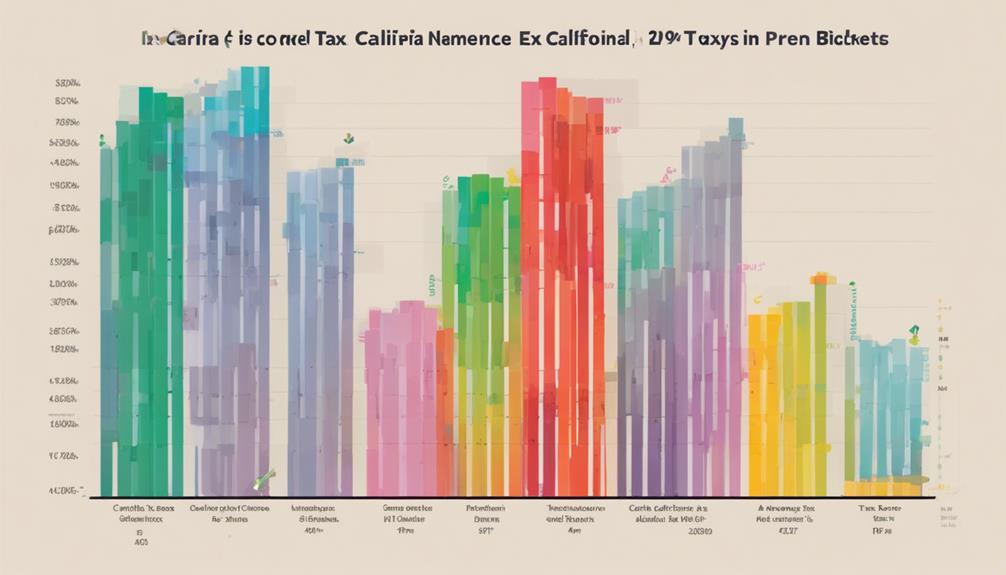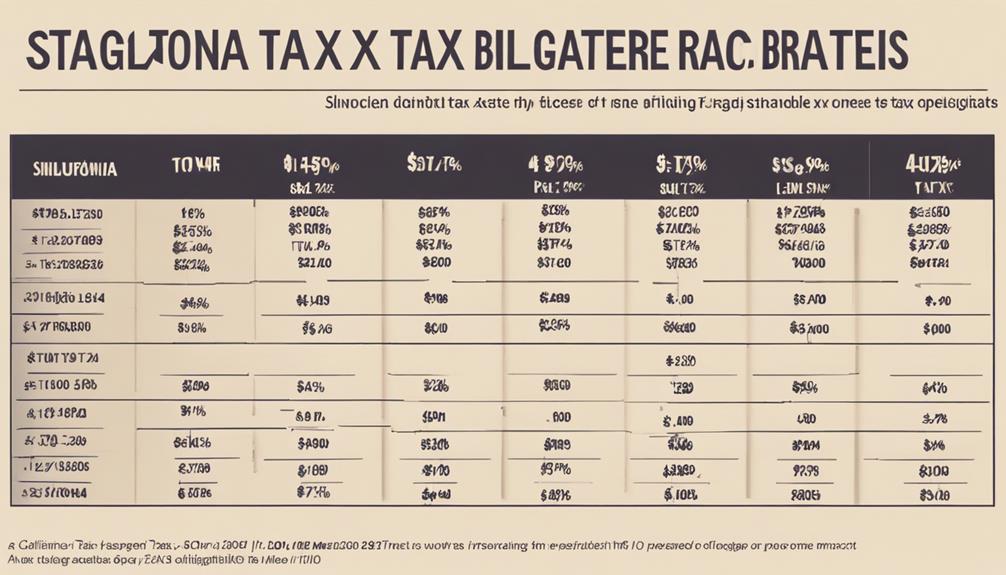As a California resident, you can't ignore the impact of the state's tax bracket structure on your 2024 tax bill. The progressive nature of the system means high earners like yourself will contribute a larger share, with the top bracket kicking in at $625,369 for single filers. Understanding how marginal tax rates apply to your taxable income is vital for optimizing deductions, minimizing your liability, and planning your finances effectively. While the calculations may seem complex, the right strategies could make a significant difference in what you owe next year.
Key Takeaways
- The California tax bracket structure with marginal rates from 1% to 13.3% determines how much of your income is taxed at each level in 2024.
- Understanding your marginal tax rate and effective tax rate can help optimize tax planning and minimize your 2024 California tax liability.
- Maximizing eligible deductions, such as charitable contributions, mortgage interest, and retirement plan contributions, can significantly reduce your taxable income in 2024.
- Filing status, dependents, and income sources can all impact your 2024 California tax bracket and overall tax bill.
- Exploring tax-saving strategies, including leveraging tax-advantaged investments and deferring taxable income, can help minimize your 2024 California tax obligation.
Understanding California Tax Brackets

California's tax bracket structure plays an essential role in determining the amount of state income tax you owe. The California tax landscape is divided into six tax brackets, each with a different marginal tax rate. These rates range from 1% for the lowest bracket to 13.3% for the highest bracket. Understanding how these brackets work is vital in planning your finances and guaranteeing you pay the right amount of taxes.
The lowest tax bracket applies to taxable income up to $9,224 for single filers and $18,448 for joint filers. As your income increases, you'll move into higher tax brackets, with the highest bracket kicking in at $625,369 for single filers and $1,250,738 for joint filers. The tax rate for each bracket applies only to the portion of your income that falls within that specific range, not your entire taxable income. This progressive structure ensures that higher-income individuals contribute a larger share of their earnings to state taxes.
Marginal Tax Rates Explained
Marginal tax rates determine how much of your income is taxed at each level. The thresholds for these brackets can substantially impact your overall tax liability. Understanding how marginal rates and bracket thresholds work will help you calculate your effective tax rate.
Marginal Rates Calculation
Understanding the tax rate calculation process is indispensable when traversing California's tax landscape. To determine your marginal tax rates, you'll need to calculate your average tax rate first. This involves dividing your total tax liability by your taxable income. Once you have your average rate, you can then identify your marginal rate, which is the rate applied to your next dollar of income.
The key is to understand how the tax brackets work. As your income increases, each additional dollar is taxed at the corresponding marginal rate for that bracket. For example, if your income falls within the 9.3% bracket, the first dollars you earn will be taxed at 1%, then 2%, and so on, until you reach the 9.3% rate. This progressive structure guarantees that your tax burden grows proportionately with your earnings. Mastering these calculations will empower you to make informed decisions and manage your California tax obligations effectively.
Bracket Thresholds Impact
The tax bracket thresholds are what determine your marginal tax rates in California. These thresholds are adjusted annually to account for inflation, ensuring that your tax burden doesn't creep up simply due to cost-of-living increases. When your income crosses a bracket threshold, the additional earnings are taxed at a higher rate, which can have a significant impact on your overall tax bill.
- Bracket adjustments are vital because they prevent bracket creep, where taxpayers are pushed into higher brackets without a real increase in their purchasing power.
- The impact of bracket thresholds is particularly pronounced for those with incomes near the top of a bracket, as a small increase in earnings can lead to a sizable jump in taxes owed.
- Understanding how these thresholds work is indispensable for optimizing your tax planning and minimizing your tax liability in California.
Effective Tax Rates
When discussing your tax liability in California, it's important to distinguish between your effective tax rate and your marginal tax rate. Your effective tax rate is the actual percentage of your income that you pay in taxes, while your marginal tax rate is the rate applied to your next dollar of income.
| Taxable Income | Marginal Tax Rate | Effective Tax Rate |
|---|---|---|
| $0 – $9,224 | 1% | 1% |
| $9,225 – $22,107 | 2% | 1.5% |
| $22,108 – $34,991 | 4% | 2.5% |
| $34,992 – $55,885 | 6% | 4% |
| $55,886+ | 8% | 6% |
Understanding the nuances of your tax rate analysis is vital for accurate tax burden projection and long-term financial planning in California. Knowing your effective tax rate helps you better estimate your total tax liability, while your marginal tax rate can inform decisions about earning additional income or taking deductions.
Calculating Taxable Income

To calculate your taxable income, you'll need to start with your gross income and then subtract any eligible deductions. Itemized deductions, like mortgage interest and charitable contributions, can materially impact your taxable income. Knowing how to properly calculate your taxable income is pivotal for determining the correct amount of California state taxes you'll owe.
Gross Income Deductions
Determining your taxable income involves subtracting various deductions from your gross income. These deductions can substantially reduce the amount of income subject to California's tax rates, ultimately lowering your overall tax bill.
Some key deductions to examine include:
- Standard deduction: This is a fixed amount that reduces your taxable income, regardless of your actual expenses. For 2024, the standard deduction for single filers in California is $4,803.
- Itemized deductions: You can choose to itemize your deductions, such as mortgage interest, charitable contributions, and medical expenses, if they exceed the standard deduction.
- Above-the-line deductions: These deductions, like contributions to a 401(k) or IRA, can be taken directly from your gross income before calculating your taxable amount.
Itemized Deductions Impact
Itemizing your deductions can considerably impact your taxable income, potentially reducing the amount you owe in California state taxes. Unlike the standard deduction, which is a fixed amount, itemized deductions are specific expenses you can claim, such as mortgage interest, state and local taxes, and charitable contributions.
Take a look at this table to see how itemized deductions can affect your taxable income:
| Filing Status | Standard Deduction | Itemized Deductions | Taxable Income |
|---|---|---|---|
| Single | $13,200 | $20,000 | $3,800 lower |
| Head of Household | $26,400 | $32,000 | $5,600 lower |
| Married Filing Jointly | $26,400 | $40,000 | $13,600 lower |
As you can see, the higher your itemized deductions, the lower your taxable income will be, potentially resulting in a smaller California state tax bill. Keep in mind, though, that the standard deduction may be more beneficial if your itemized deductions are relatively low. Carefully consider your options to maximize your tax savings.
Taxable Income Calculation
Calculating your taxable income in California involves subtracting your allowable deductions from your total income. This process is essential for determining the amount of taxes you'll owe and can be optimized through strategic taxable income planning.
- Standard deductions: If you don't itemize, you can claim the standard deduction, which reduces your taxable income. In 2024, the standard deduction for single filers is $12,800 and $25,600 for married couples filing jointly.
- Itemized deductions: You can choose to itemize your deductions, such as mortgage interest, charitable contributions, and medical expenses, if they exceed the standard deduction. This can further reduce your taxable income.
- Tax credits: Certain tax credits, like the Earned Income Tax Credit or the Child Tax Credit, can directly reduce the amount of taxes you owe, rather than just lowering your taxable income. Maximizing these credits can greatly impact your tax bill.
Deductions and Credits to Consider
When considering your 2024 California tax filing, you'll want to explore the various deductions and credits available. Charitable donations are a great way to lower your taxable income, so be sure to track and document any contributions you make throughout the year. Additionally, contributions to retirement accounts like 401(k)s and IRAs can also provide valuable deductions.
Don't overlook potential credits as well, such as the California Earned Income Tax Credit or the Child Tax Credit. These can directly reduce the amount of tax you owe, potentially putting more money back in your pocket. Take the time to review your eligibility for these and other relevant credits to guarantee you maximize your tax savings.
Filing Status and Tax Liability

Your filing status is a critical factor in determining your California tax liability. Whether you file as single, married filing jointly, head of household, or another status, your chosen filing status directly impacts the tax rates and brackets that apply to your income. Depending on your situation, your filing status can make a significant difference in the amount of taxes you owe.
- Your dependents' impact: If you have dependents, such as children or elderly parents, your filing status may qualify you for valuable tax credits and deductions, potentially reducing your overall tax bill.
- Income sources' effects: The sources of your income, whether from employment, investments, or other means, can also influence your filing status and subsequent tax liability. Carefully considering how your income streams are categorized is essential.
- Navigating through the tax brackets: California's tax brackets are designed to progressively tax higher levels of income. Understanding which bracket(s) you fall into based on your filing status and total income can help you plan and manage your tax obligations effectively.
Strategies for Minimizing Taxes
Savvy tax planning can help you minimize your California tax liability. By leveraging various tax planning strategies, you can potentially reduce your overall tax burden and optimize your financial situation. Start by considering your wealth management considerations, such as investment income, deductions, and credits. Carefully examine opportunities to maximize deductions, whether it's through charitable contributions, mortgage interest, or qualifying business expenses. Additionally, explore strategies to defer or minimize taxable income, such as retirement plan contributions or strategic asset allocation.
Don't overlook the benefits of tax-advantaged investment vehicles like California-specific municipal bonds or real estate investment trusts (REITs). These can provide tax-exempt or deferred income, potentially enhancing your after-tax returns. Stay informed about changes in California tax laws and regulations, as they may present new planning opportunities or necessitate adjustments to your existing strategies. Consult with a qualified tax professional to guarantee your tax planning aligns with your long-term financial goals and aids you in navigating the complexities of the California tax landscape.
Estimating Your 2024 Tax Bill

To estimate your California tax bill for 2024, consider your expected taxable income and filing status. Your tax return preparation will involve determining the appropriate tax bracket and rate based on your projected earnings.
- If you anticipate a higher income in 2024, you may want to explore strategies for maximizing deductions to reduce your overall tax liability. This could include contributions to retirement accounts, charitable donations, or itemizing eligible expenses.
- On the other hand, if you expect a lower income, you might consider adjusting your withholding or estimated tax payments to avoid overpaying throughout the year and potentially receiving a larger refund.
- Accurately estimating your 2024 tax bill can help you plan your finances and make informed decisions about your tax strategy. By staying informed about the California tax brackets and maximizing your deductions, you can work towards minimizing your tax burden.
Staying Compliant With Regulations
Maintaining compliance with California's tax regulations is paramount as you navigate the complexities of your 2024 tax planning. Regulatory compliance involves adhering to the reporting requirements set forth by state authorities. This means accurately estimating your taxable income, deductions, and credits to confirm you're paying the correct amount of taxes. Failing to comply can result in penalties, audits, and even legal consequences. Stay vigilant by carefully documenting your financial activities and seeking guidance from tax professionals if needed. Remember, the state tax agency closely monitors taxpayer behavior, so it's essential to be proactive and transparent in your reporting. By staying compliant, you'll avoid unnecessary headaches and focus on maximizing your tax savings within the bounds of the law. Prioritizing regulatory compliance will give you peace of mind and help you avoid costly mistakes as you plan for your 2024 tax obligations in California.
